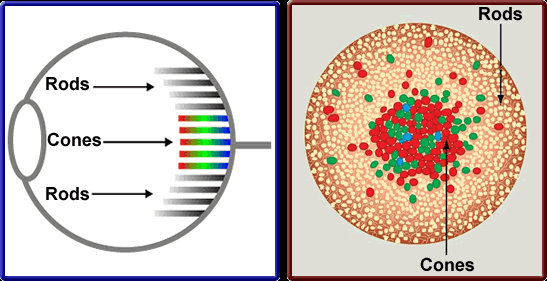Human Night Vision – How To See In The Dark, Naturally

Natural ‘Night Vision’ of the human eye is an interesting phenomenon.
The dynamic range of our eyes is remarkable. The eye can adapt to an extremely wide range of light (brightness) conditions from very bright to extreme low light conditions.
(Updated)
Human Night Vision Facts & Tips
The eye automatically adjusts to changes in brightness. Remarkably the human eye can function effectively within an extreme range in brightness from very bright to very dim.
I have read that this dynamic range is “well over 1,000,000 : 1”!
There are two primary types of receptors in the eye’s retina. They collect and send light impulses to the brain.
Rods and Cones
Without going into lots of technical detail, the basics are this:
Rods are receptive to brightness (intensity of light).
Cones are sensitive for color perception and visual acuity (focus).
The following image shows where the rods and cones are located in the eye. As you can see, the cones are mostly in the center region. The rods are all around, just not in the middle.
Hint: The Rods are what give you natural human night vision.

While both Rods and Cones in the eye function throughout a very wide range of illumination, below the intensity of moonlight the Cones cease to function.
The dimmest light in which the Cones will somewhat effectively function is similar to 50% moonlight.
However, the Rods can ‘see’ all the way down to an overcast night with no moonlight… Though with greatly reduced focus and color perception due to the Cone’s inability to function well in extreme low light.
Human Night Vision ‘Blind Spot’
The center of the eye’s visual feed is loaded with Cones. The center is completely absent of Rods. Therefore, if the ambient light is below the Cone threshold (approx. 50% moonlight), a blind spot will present itself in the central field of vision.
The Rods reach a maximum concentration at a peripheral around 17 degrees of your central vision.
“What a relief! Thanks, Ken. Thought I was losing my sight when I tried to focus directly on a star at night only to have it disappear when I looked directly at it.”
said a commenter here :=)
“You have to keep your eyes moving, your head on a swivel and not looking at the center but the edges of your vision.”
said another regarding the Army
How To See In The Dark | Natural Human Night Vision
While attempting to ‘see’ in low ambient light dimmer than moonlight (relying solely on your eye’s Rods to ‘see’)
Look approximately 15-20 degrees to one side, above, or below the target in order to place the target on the part of the retina that has the highest density of Rods.
You can also fixate to one side of a target to avoid the central blind spot, as well as to scan, utilizing the most sensitive part of the retina to improve target detection at night.
Night Vision Adaptation Of The Eye
Rods and Cones differ greatly in their rate of dark adaptation. (That’s the speed at which they adapt to changing illumination conditions).
Rods (the receptors for greatest night vision) require 45 minutes or longer of absolute darkness to attain maximum sensitivity after exposure to bright light.
The Cones do not achieve the same level of night vision sensitivity as the Rods. The Rods slowly adapt to dim illumination, but eventually achieve a much greater sensitivity than the cones.
Dark adaptation (Night Vision) is about 80% complete within 30 minutes. But it may take hours, or even days, to acquire total dark adaptation.
Poor Color Sensitivity When It’s Dark
Rods and Cones have different sensitivities to visible wavelengths of light (colors).
Color vision is lost under very low light conditions. (The Cones “don’t work”).
Rods are mostly sensitive to blue – green while less sensitive to the red portion of the visible spectrum. In other words while using human night vision, if looking off-angle at a target (15-20 degrees), Green will appear brighter than the Red.
Best Color Light For Night Vision Retention
It’s best to use a dim red light at night to retain your natural human night vision. Some flashlights and headlamps integrate with adaptable red filters or separate red LED.
THE most popular (and cost effective) Headlamp (with red light included),
Foxelli Headlamp Flashlight
(view on amzn)
[ Read: Headlamp vs Flashlight ]
Visual Acuity (Focus) At Night
Your eye’s ‘focus’ or visual acuity under low light conditions is not good. Focus is reduced at night under low illumination. 20/20 vision cannot be sustained below a level of deep twilight.
Visual acuity at night is derived from small differences in brightness between objects and their background (contrast).
Vision may be reduced to 20/200 or less.
So, lets say you have 20/20 vision. That means you can see clearly at 20 feet what typically should be seen at that distance (e.g. an eye chart).
But if you have temporary 20/200 vision (because of very low light conditions, for example), it means that a person with 20/200 vision who is 20 feet from an eye chart sees what a person with unimpaired (or 20/20) vision can see from 200 feet away.
Flash Blindness
Dark adaptation of the Rods develops slowly over a period of 20 to 30 minutes to approximately 80% ‘night vision’.
However human night vision can be lost in a few seconds of exposure to bright light.
Dark adaptation is independent in each eye. Even though bright light may shine into one eye, the other eye will retain its dark adaptation if it is protected from the light.
You can prevent flash blindness and preserve dark adaptation in one eye by simply closing or covering it. For example, if you must momentarily turn on a flashlight, you might close one eye first to retain your night vision.
Real Night Vision Devices
Okay, do you want some assist with your ‘natural’ night vision? <grin>
Speaking of night vision, I can’t help but plug Bob over at ‘Ready Made Resources’ who has the best prices on night vision devices anywhere. Although a significant investment, a Night Vision Device is a tremendous force multiplier (and has many additional uses!).
Here is his lineup of NVD’s:
The Best Prices on Night Vision Devices Anywhere

[ Read: Night Vision Devices Critical for Nighttime Security ]
[ Read: Night Vision Devices (Gen 1 – 4) ]
